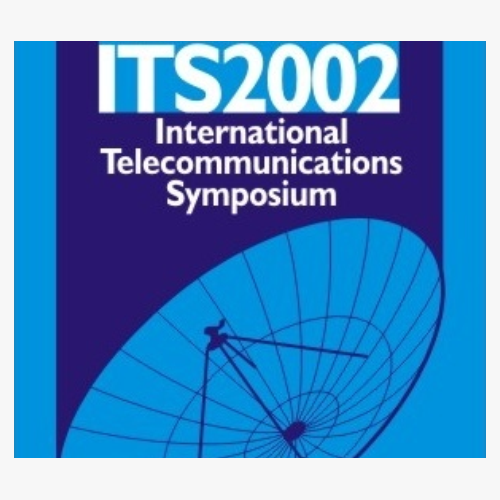
2002 International Telecommunications Symposium
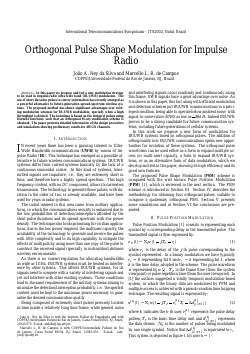
Orthogonal Pulse Shape Modulation for Impulse Radio
João A. Ney da Silva, Marcello L. R. de Campos
DOI: 10.14209/its.2002.915
Keywords:
Abstract
"In this paper we propose and test a new modulation strategy to be used in impulse-radio ultra-wide band (IR-UWB) modulation. The use of short-duration pulses to convey information has recently emerged as a powerful alternative to future-generation spread-spectrum wireless systems. The proposed method has shown significant advantages over existing modulation schemes for IR-UWB modulation, specially when a high throughput is desired. The technique is based on the design of pulses using Hermite functions, such that an orthogonal M-ary modulation scheme is obtained. The paper presents detailed information of the design procedure and simulations showing preliminary results for AWGN channels."Download

Effects of Dynamic Time Slot Scheduling Schemes and Soft Handoff on the Performance of TDD DS CDMA Systems with 2D Rake Receivers over a Nakagami-m Frequency Selective Fading Channel
Roger Pierre Fabris Hoefel, Celso de Almeida
DOI: 10.14209/its.2002.921
Keywords:
Abstract
"In this paper1, we derived analytical expressions to assess the performance of Time Division Duplexing (TDD) Direct Sequence Code Division Multiple Access (DS-CDMA) systems with coherent bidimensional (2D) Rake receivers. These results are used in the performance comparison between coherent and optimum 2D Rake receivers It is also shown that soft handoff allows gains of 2 dB in the Signal-to-Interference-plus-Noise-Ratio (SINR) at the 2D Rake receiver output. Finally, we also show that dynamic time slot allocation schemes allow considerable performance gains of users\u2019 (SINR) and network operators\u2019 (throughput multiplication) point of view."Download
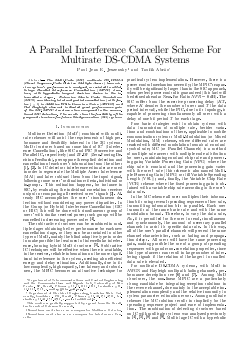
A Parallel Interference Canceller Scheme for Multirate DS-CDMA Systems
Paul Jean E. Jeszensky, Taufik Abrão
DOI: 10.14209/its.2002.927
Keywords:
Abstract
"The Multi-Code (MC) multirate DS-CDMA (Direct Sequence-Code Division Multiple Access) transmission system’s performance is analyzed, associated to a Multistage Parallel Interference Cancellation (MPIC) structure, with hyperbolic tangent decision device in the intermediate stages. Extensive Monte Carlo Simulations (MCS) considering total and partial cancellation (with factor qsi <1) in Additive White Gaussian Noise (AWGN) and Flat Rayleigh channels indicated great performance gain of the MC-MPIC structure when compared to the conventional MC detection. The results show the feasibility of the proposed structure for future third generation (3G) systems"Download
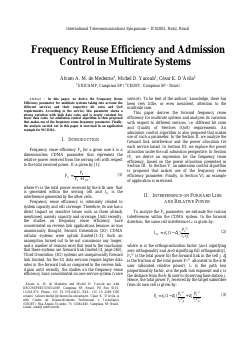
Frequency Reuse Efficiency and Admission Control in Multirate Systems
Álvaro A. M. de Medeiros, Michel D. Yacoub, César K. D’Ávila
DOI: 10.14209/its.2002.933
Keywords:
Abstract
"In this paper, we derive the Frequency Reuse Efficiency parameter for multirate systems taking into account the different services and their respective bit rates and QoS requirements. According to the service, this parameter shows a strong variation with high data rates and is nearly constant for lower data rates. An admission control algorithm is then proposed that makes use of the frequency reuse frequency parameter. Finally, the analysis carried out in this paper is exercised in an application example for WCDMA."Download
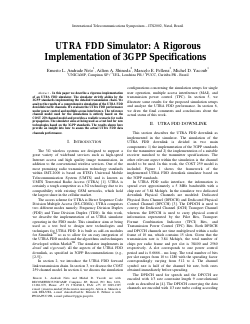
UTRA FDD Simulator: A Rigorous Implementation of 3GPP Specifications
Ernesto L. Andrade Neto, Ailton A. Shinoda, Marcelo E. Pellenz, Michel D. Yacoub
DOI: 10.14209/its.2002.939
Keywords:
Abstract
"In this paper we describe a rigorous implementation of an UTRA FDD simulator. The simulator strictly abides by the 3GPP standards implementing the detailed transmission chain. We analyze the results of a comprehensive simulation of the UTRA FDD downlink traffic channels. We evaluate the UTRA FDD performance under power control and multiple access interference. The reference channel model used for the simulations is entirely based on the COST 259 channel model and provides a realistic scenario for radio propagation. The simulator aims at being used as a test bed for new technologies based on the 3GPP standards. The results shown here provide an insight into how to assess the actual UTRA FDD data channels performance."Download
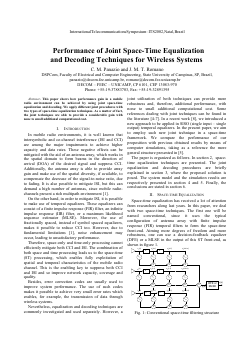
Performance of Joint Space-Time Equalization and Decoding Techniques for Wireless Systems
C. M. Panazio, J. M. T. Romano
DOI: 10.14209/its.2002.945
Keywords:
Abstract
"This paper shows how performance gain in a mobile radio environment can be achieved by using joint space-time equalization and decoding. We apply different joint procedures with two types of space-time equalization techniques. As a matter of fact, the joint techniques are able to provide a considerable gain with none to small additional computational cost."Download
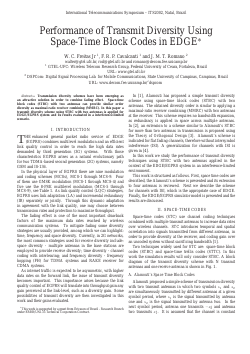
Performance of Transmit Diversity Using Space-Time Block Codes in EDGE
W. C. Freitas Jr, F. R. P. Cavalcanti, J. M. T. Romano
DOI: 10.14209/its.2002.951
Keywords:
Abstract
"Transmission diversity schemes have been emerging as an attractive solution in order to combine fading effect. Space-time block codes (STBC) with two antennas can provide similar order diversity as maximal-ratio receiver combining (MMRC). In this paper a transmit diversity scheme using STBC with two antennas is applied for EDGE/EGPRS system and its results evaluated in a interference-limited scenario."Download
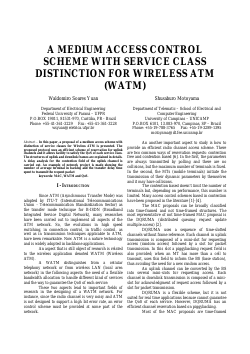
A Medium Access Control Scheme with Service Class Distinction for Wireless ATM
Waldomiro Soares Yuan, Shusaburo Motoyama
DOI: 10.14209/its.2002.956
Keywords: MAC WATM QoS
Abstract
"In this paper, a proposal of a medium access scheme with distinction of service classes for Wireless ATM is presented. The proposed protocol uses an efficient scheme of reservation for uplink channels and it allows facility to satisfy the QoS of each service class. The structures of uplink and downlink frames are explained in details. A delay analysis for the contention field of the uplink channel is carried out. An example of network project is made showing the number of average terminal in backlog and the transfer delay time spent to transmit the request packet"Download
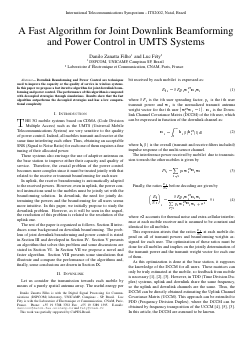
A Fast Algorithm for Joint Downlink Beamforming and Power Control in UMTS Systems
Danilo Zanatta Filho, Luc Féty
DOI: 10.14209/its.2002.962
Keywords:
Abstract
"Downlink Beamforming and Power Control are techniques used to improve the capacity or the quality of service in wireless systems. In this paper we propose a fast iterative algorithm for joint downlink beamforming and power control. The performance of this algorithm is compared with decoupled strategies through simulations. Results show that the fast algorithm outperforms the decoupled strategies and has a low computational complexity."Download

GPRS Systems Performance Analysis
Fátima de Lima Procópio Duarte, Antonio A. F. Loureiro, Leonardo Barbosa e Oliveira, Cláudio Márcio de Souza Vicente
DOI: 10.14209/its.2002.968
Keywords:
Abstract
"The increasing interest on the possibility of accessing information anytime, anywhere, associated with the development of modern portable equipments, is stimulating the mobile network evolution. This is a gradual evolution, from the firt mobile network generation, 1G, towards the fourth generation, 4G, passing through 2G, 2.5G, and 3G. Higher video, voice and image transmission capacities are reached on each generation. GSM (Global System for Mobile Communications) is a 2G technology, while GPRS (General Packet Radio Services) is a 2.5G technology. This work compares the capacity of both GSM and GPRS networks. Experimental results obtained through simulation are described, in which the number of mobile stations as well as the traffic generation rate are varied. The main results show that with the GPRS there is a greater number of mobile stations transmitting simultaneously, as it allows a multi-slot allocation. There is also an performance analysis of the GPRS environment. The delay, jitter and throughput are the performance parameters analyzed. The GPRS ideal empirical release time is indicated."Download